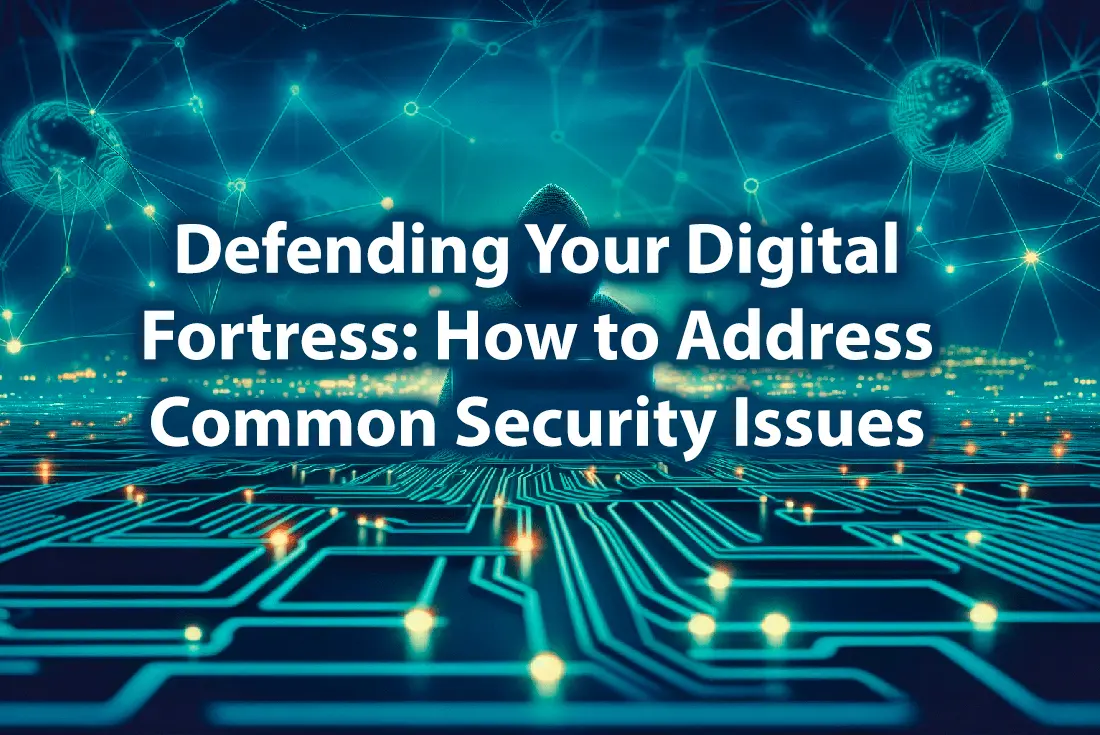
24 Apr Defending Your Digital Fortress: How to Address Common Security Issues
Do you feel confident in the security of your online accounts, devices, and the data they hold? In today’s interconnected world, cyber threats are constantly evolving, putting individuals and businesses at risk of sensitive data compromise. Understanding these common security issues and implementing proactive measures is essential for maintaining a strong digital defense. Discover the crucial strategies and best practices to safeguard your online presence and protect what matters most.
Password Protection
Passwords serve as the digital keys to our online accounts and systems. Weak or compromised passwords are significant vulnerability cybercriminals seek to exploit. Let’s delve deeper into fortifying your password practices:
Importance of Strong, Unique Passwords
Utilize long passwords (aim for a minimum of 12 characters, but longer is even better) with a combination of uppercase letters, lowercase letters, numbers, and symbols.
Avoid common words, phrases, keyboard patterns (e.g., “qwerty”), or any easily guessed personal information (birthdays, pet names, etc.).
Each online account should have a unique password; reusing passwords increases the risk of a single breach compromising multiple accounts.
Tips for Creating and Managing Secure Passwords
Consider using a password generator to create complex, random passwords. Many password managers offer this functionality.
Employ a reputable password manager to securely store and manage your unique passwords. These tools often include features like password strength analysis, breach alerts, and autofill to streamline logins.
Consider alternative authentication methods, like biometrics (fingerprint or face ID), when available.
Two-Factor Authentication (2FA)
Add a crucial layer of security with 2FA. It requires you to enter a code (often sent via SMS, an authenticator app, or a hardware token) in addition to your password during login attempts. Enable 2FA for all accounts that support it, particularly those housing sensitive data like financial platforms or email.
Security issues threatening your business? Downtown Computer Services offers comprehensive security solutions to fortify your defenses. Contact us today for a consultation and start protecting your valuable assets. Dial: (954) 524 9002.
Phishing Awareness
Phishing attacks employ sophisticated social engineering tactics to deceive users into divulging sensitive information, downloading malware, or even wiring money. Vigilance and a critical eye are essential defenses against these ever-evolving threats. Let’s discuss the definition of phishing and common tactics used by cybercriminals.
Phishing refers to fraudulent communications, typically emails, text messages, or fake websites designed to mimic legitimate sources to trick recipients.
Beyond simple misspellings, attackers use lookalike domains that differ by a single character (e.g., amaz0n.com)
Phishing emails often contain manipulative language to create a sense of urgency (“Your account has been compromised – click here”) or impersonate trusted brands, even mimicking internal company communication styles.
Links or attachments often contain malware or lead to fraudulent login pages designed to capture your credentials.
How to Spot and Avoid Phishing Attempts
- Carefully scrutinize sender addresses for misspellings, unusual domains, or generic addresses (e.g., [email address removed] rather than an individual’s name)
- Be wary of alarmist language, unexpected requests for personal or financial information, or claims of prizes you didn’t enter to win.
- Hover over links (without clicking) to verify the true destination. Look out for mismatches between the displayed link and its actual URL.
- Do not open unexpected attachments, even from seemingly known senders. If unsure, contact the sender through a verified, separate channel to confirm the attachment’s legitimacy.
- When in doubt, contact the company or individual directly (using a phone number or email address obtained from a trusted source, not the suspicious message itself) to verify any requests.
Importance of Educating Employees or Family Members About Phishing
Individuals less familiar with technology or online threats may be more susceptible to phishing scams. Conduct regular training sessions for employees emphasizing phishing identification and reporting procedures. Consider using simulated phishing tests to gauge awareness levels. Provide informational resources about phishing threats for family members, especially the elderly, who are often targeted by fraudsters.
Software Updates and Patch Management
Outdated software is a playground for cybercriminals, riddled with vulnerabilities waiting to be exploited. Regular software updates and proactive patch management are essential components of a robust security strategy. Software updates often include security patches that address known vulnerabilities, plugging security holes attackers seek to exploit. Failing to keep software up-to-date leaves your devices and systems at significant risk. Beyond security fixes, updates may also introduce new features and performance enhancements, further incentivizing keeping your software current.
It’s important to establish a disciplined update routine. Whenever possible, enable automatic updates for your operating systems and frequently used applications. This takes the burden off you to remember to check for new versions manually. For software products that don’t offer automatic updates, make a habit of regularly checking the manufacturer’s website or within the software itself for available updates. Pay close attention to notifications about critical or urgent security updates – these must be prioritized and applied as soon as possible.
Patch management refers to the process of identifying, prioritizing, and deploying security patches across systems and applications. For businesses, this is a complex and ongoing task. Centralized patch management tools streamline this process, ensuring timely and comprehensive vulnerability mitigation across an organization’s entire network.
Secure Wi-Fi Networks
Wireless networks, both at home and in the office, can be entry points for attackers if left unsecured. Taking proactive steps to secure your Wi-Fi network is essential to protect your data. Begin by changing the default network name (SSID) and administrative password for your router. Attackers have easy access to lists of default settings for various router brands, so utilizing unique credentials significantly improves your security from opportunistic attacks. Next, choose the strongest encryption protocol your router supports. WPA2 or the newer WPA3 offer robust protection.
Regularly updating your router’s firmware ensures you have the latest security patches released by the manufacturer. Many routers also have built-in firewalls, which provide an additional layer of network protection. If you frequently have visitors to your home or office, consider creating a separate guest network with restricted access to your main network. This enhances privacy and adds a layer of security.
Public Wi-Fi networks often lack basic security measures, making them risky for sensitive activities. Limit your reliance on these networks for anything involving financial transactions or personal information. If you must use public Wi-Fi, a VPN (Virtual Private Network) is a smart precaution. VPNs create an encrypted tunnel, obscuring your traffic from any potential eavesdroppers on the public network. Be aware of your surroundings while using public Wi-Fi, as physical “shoulder surfing” is a tactic used by criminals to try and glimpse private information on your screen.
Data Encryption
Data encryption scrambles information, making it unreadable without the correct decryption key. It offers a powerful layer of protection for sensitive data, whether stored on devices (data at rest) or sent over networks (data in transit). Think of encryption as using a secret code to write a message – only someone knowing how to decode it can make sense of the content. This safeguards confidential data like financial information, personal records, and intellectual property from unauthorized access.
Many devices and operating systems now offer built-in encryption options, such as BitLocker for Windows and FileVault for macOS, making it easy to add this layer of protection to your stored data. For even more granular control over specific files or documents, consider using dedicated encryption software. When utilizing cloud storage providers, ensure you understand their security measures and inquire about encryption options for protecting your data stored on their servers.
End-to-end encryption (E2EE) takes data privacy a step further and is especially important for messaging apps. With E2EE, only the sender and intended recipient have the keys to decrypt messages. Even the company providing the messaging service can’t access the message content, ensuring a high level of privacy for your communications. Look for messaging apps that prioritize security and explicitly advertise their use of end-to-end encryption.
Ransomware Prevention
Ransomware is malicious software that encrypts a victim’s files, rendering them inaccessible, and then demands payment in exchange for the decryption key. Taking proactive steps to prevent a ransomware attack is crucial as recovery can be difficult and costly, even if you decide to pay the ransom. Ransomware attacks often begin with deceptive tactics, like phishing emails or infected downloads that trick users into giving the malware access to their systems. Once executed, the ransomware scans for valuable data, encrypting it, and then displays a ransom note demanding payment (usually in cryptocurrency) to restore access to your files.
Keeping systems and software up to date with the latest security patches plugs known vulnerabilities that ransomware often exploits. Exercising caution with emails and attachments, especially from unknown senders, reduces your risk of inadvertently triggering a ransomware infection. Educating employees about how to spot phishing attempts and the devastating consequences of a ransomware attack makes them an important part of your defense. Antivirus and more sophisticated endpoint security solutions provide an additional layer of protection but shouldn’t be relied on alone.
Perhaps the most important safeguard against ransomware is a robust backup strategy. Maintain regular, offline or offsite backups of your critical data. Offline backups are crucial as ransomware may search for connected backups and encrypt those as well. The ability to restore from a clean backup makes ransomware far less devastating. Regularly test your backups to ensure you can easily recover your data when needed.
Conclusion
The digital landscape is fraught with security risks that evolve every day. By understanding the common security issues discussed and implementing the recommended precautions, you can significantly strengthen your defenses. Remaining vigilant, proactive, and continually learning about new threats is essential for defending your digital fortress.
If you’re a small business concerned about your cybersecurity posture, it’s time for a security health check. Downtown Computer Services offers comprehensive security assessments and solutions tailored to your needs. Don’t leave your business vulnerable – contact them today for peace of mind. Call us today to discover how our expert guidance and protective solutions can secure your sensitive data: (954) 524 9002.
Check out other relevant news
- How Easy-to-Use Hacking Tools Are Fueling Cybercrime
- Cryptocurrency Security for Small Businesses: Protecting Your Wallet
- The Infostealer Epidemic: Protecting Your Business from the Latest Wave of Cyberattacks
- The Identity Crisis: How Compromised Credentials Can Cripple Your Business
- Beyond the Brick and Mortar: Building Your Online Storefront with Digital Marketing
